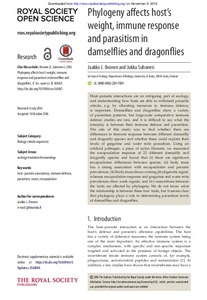Phylogeny affects host’s weight, immune response and parasitism in damselflies and dragonflies
Jaakko J. Ilvonen; Jukka Suhonen
https://urn.fi/URN:NBN:fi-fe2021042715734
Tiivistelmä
Host-parasite interactions are an intriguing part
of ecology, and understanding how hosts are able to withstand parasitic
attacks, e.g. by allocating resources to immune defense, is important. Dragonflies
and damselflies show a variety of parasitism patterns, but large-scale
comparative immune defense studies are rare and it is difficult to say what the
interplay is between their immune defense and parasitism. The aim of this study
was to find whether there are differences in immune response between different
dragonfly and damselfly species and whether these could explain their levels of
gregarine and water mite parasitism. Using an artificial pathogen, a piece of
nylon filament, we measured the encapsulation response of 22 different
dragonfly and damselfly species and found that (i) there are significant encapsulation differences between species,
(ii) body mass has a strong association
on encapsulation and parasitism levels, (iii)
body mass shows a strong phylogenetic signal whereas encapsulation response and
gregarine and water mite parasitism show weak signals and (iv) associations between the traits are affected by phylogeny. We
do not know what the relationship is between these four traits, but it seems
clear that phylogeny plays a role in determining parasitism levels of
damselflies and dragonflies.
Kokoelmat
- Rinnakkaistallenteet [27094]
